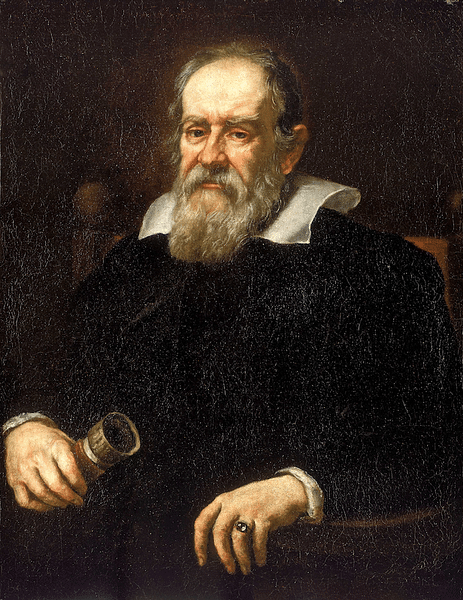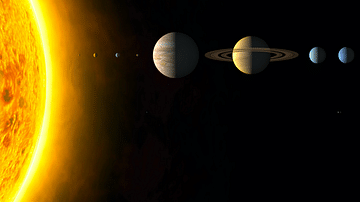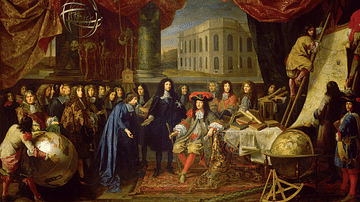
Galileo Galilei (1564-1642) was an Italian mathematician, physicist, astronomer, and natural philosopher. He created a superior telescope with which he made new observations of the night sky, notably that the surface of the Moon has mountains, that Jupiter has four satellite moons, and that the sunspots of the Sun, under careful observation, reveal that it is a moving sphere.
Besides astronomy, Galileo conducted many other scientific experiments over his long lifetime as he was greatly interested in physics. Testing age-old theories and coming up with new ones after meticulous experimentation, the scientist fell foul of the Catholic Church for questioning the accepted Ptolemaic view of the universe. Found guilty of heresy in a trial in 1633, Galileo was obliged to live his final years under house arrest at his villa in Tuscany. His discoveries and, above all, his approach to experimentation and testing hypotheses made Galileo an influential figure in the Scientific Revolution.
Early Life
Galileo Galilei was born in Pisa, Italy, on 15 February 1564. His family belonged to the minor nobility but was rather down on its luck. Galileo inherited an interest in science from his father, Vincenzo Galilei (c. 1520-1591), who wrote treatises based on his practical experiments in musical science. Vincenzo might have earned acclaim in music, but he earned money as a cloth merchant, the family of his wife and Galileo's mother Giulia being in that trade. From 1581, Galileo studied medicine at the University of Pisa, but it was the mathematics part of the course (then part of a traditional education in medicine) that appealed to him most. So much so that Galileo left Pisa without graduating and took up a post as a mathematics teacher in Florence. Galileo was keen to make his mark, and his private studies resulted in his first contribution to the ever-growing knowledge of the Scientific Revolution. Galileo studied the action of pendulums and formed his theory of constant motion. Such was Galileo's expertise in mathematics that he was awarded a position in that field at the University of Pisa in 1589; three years later, he was made the professor of mathematics at the University of Padua.
It was at Padua that Galileo began a life-long friendship with the philosopher Cesare Cremonini (1550-1631). Galileo also met Marina Gamba in Padua, and although they never married, they had three children together: Virginia (b. 1600), Livia (b. 1601), and Vincenzio (b. 1606). Galileo was never far from financial distress, and he supplemented his meagre lecturer's income with private lessons and the occasional detailed horoscope. In 1613, when his daughters reached their teens, Galileo, unable to live openly with his mistress, entered Virginia and Livia into a nunnery outside Florence (both became nuns when reaching maturity). Galileo supported his daughters in the nunnery, buying better rooms and supplying them with food grown on his own estate to supplement the rather meagre standard fare of the nunnery. Virginia, by then known as Maria Celeste, was a great help to her father in his old age.
From Theory to Practice: A New Science
Mathematics was crucial to Galileo's understanding of the universe, as here he explains in his The Assayer of 1623:
One cannot understand it unless one first learns to understand the language and recognize the characters in which it is written. It is written in mathematical language and the characters are triangles, circles and other geometrical figures; without these means it is humanly impossible to understand a word of it; without these there is only clueless scrabbling around in a dark labyrinth.
(Wootton, 163).
But Galileo was an all-round thinker interested in any discipline of thought that would provide the answers to the problems he wished to solve. His first biographer, Vincenzo Viviani, notes the following (paraphrased by Heilbron):
[He] could compete with the best lunatists in Tuscany, advise painters and poets on matter of artistic taste, and recite vast stretches of Petrarch, Dante, and Ariosto by heart. But his great strength, Galileo said when negotiating for a post at the Medici court in 1610, was philosophy, on which he had spent more years of study than he had months on mathematics. (v)
In short, Galileo "was no more (or less!) a mathematician than he was a musician, artist, writer, philosopher, or gadgeteer…Galileo would have done well in any of several professions" (ibid).

It was in the 1590s that Galileo began to move away from pure mathematical studies towards experimentation, although the story he dropped cannonballs from the Leaning Tower of Pisa is apocryphal. Rejecting the old Aristotelian understanding of physics, Galileo studied such subjects as uniform acceleration, inertia, and mechanics in his private workshop. He discovered all sorts of startling physical facts, such as a falling object has the same rate of acceleration regardless of its weight (which means, if air resistance is removed, two falling objects, though of different weight, will hit the ground at the same time), that a projectile follows a parabola in its path from one spot to another, and that a body moving on a perfectly smooth surface rolls on at a constant speed and, in a vacuum, would do so indefinitely. This latter point was used by Galileo to explain an age-old problem. If the Earth revolves around the Sun, then what causes it to move? Galileo demonstrated that, assuming God had started it off at the Creation, no continuous force was needed.
Galileo became deeply interested in astronomy and, from 1597, began an enduring correspondence with that other great thinker and astronomer Johannes Kepler (1571-1630). These two men would find the physical evidence to confirm the controversial theories of Nicolaus Copernicus (1473-1543) and finally bury the outdated ones of Ptolemy (c. 100 to c. 170). Copernicus believed the Earth revolved around the Sun, while Ptolemy believed the Sun revolved around the Earth (a view favoured by the Church). Galileo rejected the traditional working methods of the medieval astronomer, which was to create meticulous charts and tables using complex mathematics, and instead focussed his telescope on direct observation and discovery. In this sense, "Galileo fundamentally changed the notion of what astronomy was about" (Burns, 63).

Galileo's Telescope
The first telescope was invented in the Netherlands around 1608, perhaps by Hans Lippershey (c. 1570 to c. 1619). The simple idea of using a convex and concave lens at either end of a tube soon spread around Europe, and it reached Galileo's ears within a year or two. Galileo built his own version using superb lenses, which he ground himself (although he would not tell anyone exactly how). Going through several prototypes, Galileo arrived at a telescope with a magnification of 33 diameters, far more powerful than any in possession of his contemporaries. Galileo's telescope, what he called his occhiale ('eyeglass'), had two lenses set at either end of a lead tube around 60 cm (24 in) long. It was so powerful and well-made that other scientists had trouble believing what Galileo claimed to see through it since their own telescopes failed to spot what the Italian could see. Galileo even invented a pair of binoculars, but the idea did not catch on. Other gadgets Galileo invented early versions of include the thermometer (actually a thermoscope), a hydrostatic balance, and a compass (what we today would call a military compass or sector). It was the telescope, though, which revolutionised thought in the 17th century.
Galileo used his new telescope to study the heavens in tremendous detail, publishing the fruit of his research in Sidereus Nuncius (The Starry Messenger) in 1610. Galileo was able to observe the Moon and note that its surface seemed similar to Earth's with mountains and valleys, suggesting it was not, as many had previously thought, made of some entirely different matter. Galileo spotted for the first time the four largest moons of Jupiter (we now know there are more), studied the composition of the Milky Way, and identified the phases of Venus, which proved that it orbits the Sun. Galileo built theories on what he saw, such as the movement of Jupiter's moons must mean they orbit Jupiter (and not some other body like the Sun). He believed (correctly) that just as we can see the shine of the Moon, so on the Moon one should be able to see the shine of the Earth, that is the reflected light of the Sun. These new discoveries made Galileo as famous as Christopher Columbus (1451-1506), the discoverer of the New World, with whom, as the discoverer of a new Cosmos, Galileo was frequently compared.
Galileo's most important discovery, though, was not the details of the Moon or Jupiter's satellites but his observation of the sunspots on the Sun, using his telescope. The sunspots had been noted in antiquity, but Galileo could now, using filters, see things nobody had ever seen before. Galileo described what he saw:
The dark spots seen in the solar disk by means of the telescope are not at all distant from its surface, but are either contiguous to it or separated by an interval so small as to be quite imperceptible…They vary in duration from one or two days to thirty or forty. For the most part they are of most irregular shape, and their shapes continually change, some quickly and violently, others more slowly and moderately…Besides all these disordered movements they have in common a general uniform motion across the face of the sun in parallel lines. From special characteristics of this motion one may learn that the sun is absolutely spherical, that it rotates from west to east and around its own centre, carries the spots along with it in parallel circles, and completes an entire revolution in about a lunar month.
(Fermi, 57).
In order to secure a position at the court of Cosimo II de' Medici, Grand Duke of Tuscany (r. 1609-1621), Galileo cleverly named the moons of Jupiter he had discovered the 'Medicean stars' in honour of the Medici family. Sure enough, in 1610, Galileo was appointed the duke's official mathematician and natural philosopher (the latter title now allowed Galileo to present theories on the place of Earth in the universe, something a lowly mathematician could not do). In 1611, Galileo was admitted into the prestigious scientific society in Rome called the Academia dei Lincei. In 1612, Galileo's Discourse on Floating Bodies attacked Aristotelian natural philosophy. In 1613, Galileo presented his pro-Copernicus theories in Letters on Sunspots, a work that landed the scientist into serious trouble.

The Trial of Galileo
Ptolemy had presented the theory that Earth was the centre of the universe with everything revolving around it. The Christian Church liked this idea since it put humanity at the centre of things. Copernicus presented his theory that it was the Sun which was at the centre and Earth and other planets revolved around it. This the Catholic Church, in particular, did not like. When Galileo sided with Copernicus, whose work was put on the Catholic Church's Index of Forbidden Books in 1616, he opened himself to the possibility of formal censure for heresy. Galileo was not denying the existence of God but, perhaps crucially, he had made many personal enemies over the years besides institutional ones. There was, for example, a notable feud with the Jesuit astronomer Christoph Scheiner (1573-1650). Galileo, it seems, had a particular skill for rubbing up people the wrong way (this was one reason why he left Pisa for Padua back in 1592). His delight in poking fun at the beliefs of others and his skill at philosophical discussion where he pulled such beliefs apart made him as few friends as Socrates had done in 5th-century BCE Athens. On the other side, Galileo was also good at gaining friends and supporters since he was "a forceful publicist of his own ideas and a superb communicator of technical ideas" (Henry, 29). In short, Galileo was a sticky problem to handle for the Church.
Most astronomers were not actually interested in challenging religious orthodoxy and did not view their new discoveries using telescopes and other instruments as necessarily challenging a universe created as described in the Bible. Galileo considered theology and natural philosophy as entirely different subjects. What he was doing was showing that the physical world on Earth was entirely related in terms of matter and physical laws to what could be seen in the heavens. This went against the traditional Aristotelian view. In the end, Galileo's writings were not banned by the Church, but he was taken to one side and privately admonished by Cardinal Robert Bellarmine (1542-1621). Galileo was by now a public figure, especially since he wrote his works in Italian rather than the more audience-restricted Latin most other great thinkers used. Galileo's works were also translated into several other languages shortly after publication. In a meeting on 26 February 1616, Galileo was encouraged not to pursue his pro-Copernicus theories, which appeared to contradict the Bible. This he did, for a while, but the Copernicus view of the universe was now becoming more and more widely accepted following the work of other astronomers. There was, too, some middle ground, with Tycho Brahe (1546-1601) famously endorsing a compromise view that the Sun orbited Earth and the other planets orbited the Sun. In short, the problem of what revolved around what was not going away, no matter how much the Church wanted to brush the investigations of the astronomers under the ecclesiastical carpet of accepted doctrine.
In 1632, Galileo wrote his Dialogue on the Two Chief Systems of the World. Here, he has two great thinkers, one pro-Ptolemy and the other pro-Copernicus, argue the matter of which bodies revolve around what in our galaxy (and by now, Galileo was convinced what we could see through a telescope was only a galaxy and not the entire universe). There is a third character, a neutral thinker who is ultimately persuaded to accept the Copernicus model. Tellingly, the pro-Ptolemy philosopher is called Simplicio (suspiciously like 'simpleton'), and the other, really Galileo himself, is called Salviati (hinting at salvation through correct knowledge). The Dialogue was a step too far for the Church, and Galileo was accused of heresy. He was hauled before a panel for trial in 1633. Found guilty, Galileo had to desist from promoting pro-Copernicus theories, and he was obliged to stay under house arrest in his home in Florence for the remainder of his life. He also had to recite the Penitential Psalms once every week for the next three years, a minor but no doubt annoying punishment for a man who so valued his time.
Galileo might have become an enemy of Catholicism, but his case has certain unique features, not least the long line of enemies the scientist had created who now took their opportunity for revenge. As the historian J. Henry notes, "The Galileo affair should not be taken as a general indicator of relations between science and religion in the early modern period" (86).
Death & Legacy
Galileo spent his remaining time designing a pendulum clock, and he wrote a summary of all his work in physics in Discourse on Two New Sciences, completed in 1638, but, because of his trial and punishment, published in Leiden in the Netherlands. Galileo eventually lost his eyesight (endlessly peering through lenses might have been responsible for this), and he suffered from arthritis. The tranquillity of his forced retirement was only broken by occasional visits from outsiders such as the poet John Milton.
Galileo still pressed on with his studies, especially the pendulum and the attempt to find a working navigational aid for mariners, but just as his visual world had diminished from the stars to the hand before his face, the end was closing in. "I do not stop with my speculations, although with considerable damage to my health, since along with my other troubles they deprive me of sleep, which increases my melancholy at night" (Heilbron, 348). Galileo died on 8 January 1642; he was 77 years old. His remains were buried in the Church of Sante Croce in Florence.
Other thinkers came along and built upon and very often corrected the ideas that Galileo had presented. Johannes Kepler created a new model of the universe where the planets moved in elliptical orbits, not in perfect circles as Galileo had thought. Isaac Newton (1642-1727) discovered the force of gravity, and this explained phenomena that had puzzled Galileo, such as how the planets rotate, maintain their satellite moons, and move at different speeds depending on their distance from the Sun. Galileo, though, had made a much more lasting contribution to world knowledge than any specific discovery or theory. Galileo had uniquely combined the theory of mathematics, the observations of natural philosophy, and the use of repeated experiments to test hypotheses. As a consequence, he created a new and more rigorous methodology of inquiry that became the standard approach adopted by all other serious thinkers during the Scientific Revolution, a period when science relentlessly sought out new and definitive answers to questions humanity had been posing for millennia.








